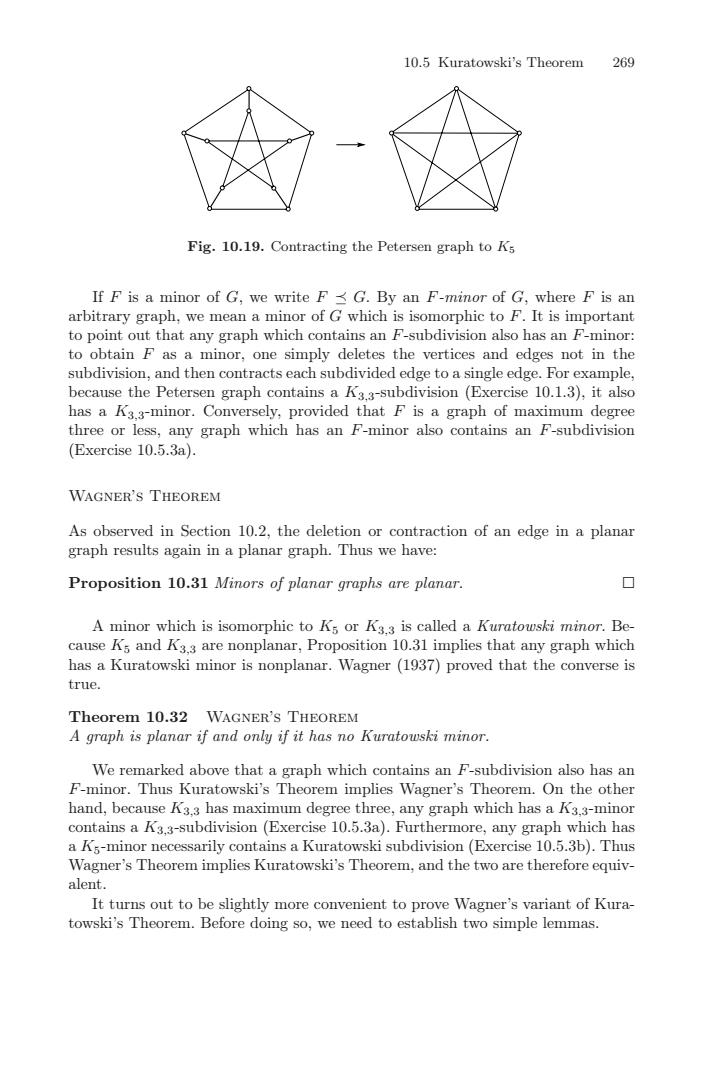正在加载图片...

26910.5Fig. 10.19. Contracting the Petersen graph to KsIf F is a minoiorofG.wewriteF<G.ByanF-minorofG.whereFisalarbitrary graph, we mean anorofG whichis isomorphic to F.It is importanttopoint out that any graph whichcontains an F-subdivision alsohas an F-minor:to obtain F as a minor, one simply deletes the vertices and edges not im thesubdivision, and then contracts each subdivided edge to a single edge.For examplebecause the Petersen graph contains a K3.3-subdivision (Exercise 10.1.3), it alsohas a K3.3-minor, Conversely, provided that F is a graph of maximum degreethree or less, any graph which has an F-minor also contains an F-subdivision(Exercise 10.5.3a)WAGNER'S THEOREMAs observed in Section i0.2, the deletion or contraction of an edge in a planargraph results again in a planar graph. Thus we haves口Proposition 10.31 Minors of planar graphs are planarA minor which is isomorphic to K, or K3.3 is called a Kuratouski minor. Because Ks and K3,3 are nonplanar, Proposition 10.31 implies that any graph whichhas a Kuratowski minor is nonplanar. Wagner (1937) proved that the converse istrueWAGNER'STHEOREMTheorem 10.32A graph is planar if and only if it has no Kuratowski minoWererked above thataph which coF-subdivisionalsnhtF-minor.Thus Kuratowski's Theorem implies Wagner's Theorem.On the otherhand, because K3.3 has maximum degree three, any graph which has a K-contains a K3,3-subdivision (Exercise 10.5.3a).Furthermore, any graph which hasa Kg-minor necessarily contains a Kuratowski subdivision (Exercise 10.5.3b). ThusWagner's Theorem implies Kuratowski's Theorem, and the two are therefore equiv-alentIt turns out to be slightly more convenient to prove Wagner's variant of Kura-towski's Theorem. Before doing so, we need to establish two simple lemmas10.5 Kuratowski’s Theorem 269 Fig. 10.19. Contracting the Petersen graph to K5 If F is a minor of G, we write F G. By an F-minor of G, where F is an arbitrary graph, we mean a minor of G which is isomorphic to F. It is important to point out that any graph which contains an F-subdivision also has an F-minor: to obtain F as a minor, one simply deletes the vertices and edges not in the subdivision, and then contracts each subdivided edge to a single edge. For example, because the Petersen graph contains a K3,3-subdivision (Exercise 10.1.3), it also has a K3,3-minor. Conversely, provided that F is a graph of maximum degree three or less, any graph which has an F-minor also contains an F-subdivision (Exercise 10.5.3a). Wagner’s Theorem As observed in Section 10.2, the deletion or contraction of an edge in a planar graph results again in a planar graph. Thus we have: Proposition 10.31 Minors of planar graphs are planar. A minor which is isomorphic to K5 or K3,3 is called a Kuratowski minor. Because K5 and K3,3 are nonplanar, Proposition 10.31 implies that any graph which has a Kuratowski minor is nonplanar. Wagner (1937) proved that the converse is true. Theorem 10.32 Wagner’s Theorem A graph is planar if and only if it has no Kuratowski minor. We remarked above that a graph which contains an F-subdivision also has an F-minor. Thus Kuratowski’s Theorem implies Wagner’s Theorem. On the other hand, because K3,3 has maximum degree three, any graph which has a K3,3-minor contains a K3,3-subdivision (Exercise 10.5.3a). Furthermore, any graph which has a K5-minor necessarily contains a Kuratowski subdivision (Exercise 10.5.3b). Thus Wagner’s Theorem implies Kuratowski’s Theorem, and the two are therefore equivalent. It turns out to be slightly more convenient to prove Wagner’s variant of Kuratowski’s Theorem. Before doing so, we need to establish two simple lemmas